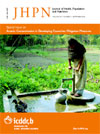
|
The Journal of Health, Population and Nutrition
icddr,b
ISSN: 1606-0997
EISSN: 1606-0997
Vol. 27, No. 4, 2009, pp. 587-597
|
 Bioline Code: hn09056
Bioline Code: hn09056
Full paper language: English
Document type: Research Article
Document available free of charge
|
|
|
The Journal of Health, Population and Nutrition, Vol. 27, No. 4, 2009, pp. 587-597
| en |
HIV/AIDS Interventions in Bangladesh: What Can Application of a Social Exclusion Framework Tell Us?
Khosla, Nidhi
Abstract
Bangladesh has maintained a low HIV prevalence (of less than 1%) despite multiple risk factors. However, recent serological surveillance data have reported very high levels of HIV infection among a subgroup of male injecting drug-users (IDUs). This suggests that an HIV/AIDS epidemic could be imminent in Bangladesh. Although biomedical and behavioural change projects are important, they do not address the root causes of observed risky behaviours among ‘high-risk’ groups. In Bangladesh, these groups include sex workers, IDUs, males who have sex with males, and the transgender population-hijra-who are all excluded groups. Using a social exclusion framework, this paper analyzed existing literature on HIV in Bangladesh to identify social, economic and legal forces that heighten the vulnerability of such excluded groups to HIV/AIDS. It found that poverty and bias against women are major exclusionary factors. The paper presents areas for research and for policy action so that the social exclusion of high-risk groups can be reduced, their rights protected, and an HIV epidemic averted.
Keywords
Acquired immunodeficiency syndrome; Gender issues; HIV; Homosexuality; Needle-sharing; Sex behaviour; Social exclusion; Stigmatization; Bangladesh
|
| |
© Copyright 2009 - International Centre For Diarrhoeal Disease Research, Bangladesh
Alternative site location: http://www.jhpn.net
|
|
